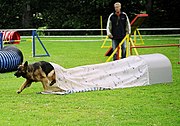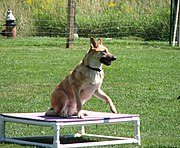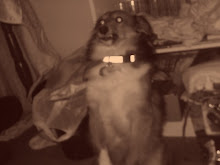
Ooooo! I am so excited about tomorrow! Mommy is starting agility with me! She said she was gonna do it for the longest time, and now she is finally doing it! We are going to the PetSafe Village Dog Park where they have a 'play' Agility Course! What luck! Then mom is signing me up for classes!!!!!!!!!!!!!!!YIPPPEEEEE!
Come back tomorrow and I will let you know how I do!
Dog agility is a dog sport in which a handler directs a dog through an obstacle course in a race for both time and accuracy. Dogs generally run off-leash with no food or toys as incentives. The handler can touch neither dog nor obstacles, except accidentally. Consequently, the handler's controls are limited to voice, movement, and various body signals, requiring exceptional training of the animal.
In its simplest form, an agility course consists of a set of standard obstacles, laid out by an agility judge in a design of his own choosing on a roughly 100 by 100 foot (30 by 30 m) area, with numbers indicating the order in which the dog must complete the obstacles.
Courses are complicated enough that a dog could not complete them correctly without human direction. In competition, the handler must assess the course, decide on handling strategies, and direct the dog through the course, with precision and speed equally important. Many strategies exist to compensate for the inherent difference in human and dog speeds and the strengths and weaknesses of the various dogs and handlers.
Contact obstacles
- A-frame
- Two broad ramps, usually about 3 feet (1 m) wide by 8 to 9 feet (3 m) long, hinged together and raised so that the hinged connection is between five and six-and-a-quarter feet above the ground (depending on the organization), roughly forming an A shape. The bottom 36 to 42 inches (1 m) of both sides of the A-frame are painted a bright color, usually yellow, forming the contact zone, onto which the dog must place at least one paw while ascending and descending. Most sanctioning organizations require that A-frames have low profile, narrow, horizontal slats all along their length to assist the dog's grip going up and down. Some organizations allow the top of the A-frame to be narrower than the bottom.
- Dogwalk
- Three 8 to 12 ft (3 to 4 m) planks, 9 to 12 inches (25 to 30 cm) wide, connected at the ends. The centre plank is raised to about 4 feet (1.2 m) above the ground, so that the two end planks form ramps leading up to and down from the center plank. This obstacle also has contact zones. Most sanctioning organizations also require slats on the dogwalk ramps.
- Teeter-totter (or seesaw)
- A 10 to 12 foot (3 to 4 m) plank pivoting on a support, much like a child's seesaw. It is constructed slightly off-balance so that the same end always returns to the ground. This is done either by placing the support slightly off-center or else weighting one end of the board. This obstacle also has contact zones. However, unlike the other contact obstacles, the teeter-totter does not have slats. The balance point and the weight of the plank must be such that even a tiny dog, such as a Chihuahua, can cause the high end of the teeter-totter to descend to the ground within a reasonable amount of time, specified by the sanctioning organization's rules (usually about 2 seconds). Smaller dogs get more time to run a course, and this is one reason why it can take them longer than it takes larger dogs.
- Crossover
- A 4-foot (1.2 m) high, 3-foot-by-3-foot (1-meter-by-1-meter) square platform , with ramps similar to those found on a dogwalk descending from the center of three or four of its sides. The dog must ascend the correct ramp and then descend the ramp indicated by the handler, possibly changing direction to do so. This has not been a commonly used obstacle, mainly because of its size. No major agility organization in the United States currently allows the use of a crossover, but the crossover is allowed by other organizations such as the Agility Association of Canada and The Kennel Club.
Tunnels
- Tunnel (or chute or rigid tunnel)
- A vinyl tube, 10 to 20 feet (3 to 6 m) long and about 2 feet (60 cm) in diameter, through which the dog runs. The tunnel is constructed of flexible vinyl and wire, such that it can be configured in a straight line, or in a variety of curves.
- Collapsed tunnel (or chute or cloth tunnel)
- A barrel-like cylinder with a tube of fabric attached around one end. The fabric extends about 8 to 12 feet (3 to 4 m) and lies closed until the dog runs into the open end of the chute and pushes his way out through the fabric tube.
- Other tunnels
- UKC agility allows two additional tunnel types, the crawl tunnel and the hoop tunnel, that are not found in other agility organizations. CPE allowed an interconnected set of tunnels called a tunnel maze from 2004 though 2006, but discontinued the tunnel maze as of the 2007 rulebook..
Jumps
- Jump (or hurdle)
- Two uprights supporting a horizontal bar over which the dog jumps. The height is adjusted for dogs of different heights. The uprights can be simple stanchions or can have wings of various shapes, sizes, and colors.
- Double and triple jump (or spread jump)
- Two uprights supporting two or three horizontal bars spread forward or back from each other. The double can have parallel or ascending horizontal bars; the triple always has ascending bars. The spread between the horizontal bars is sometimes adjusted based on the height of the dog.
- Panel jump
- Instead of horizontal bars, the jump is a solid panel from the ground up to the jump height, constructed of several short panels that can be removed to adjust the height for different dog heights.
- Broad jump (or long jump)
- A set of four or five slightly raised platforms that form a broad area over which the dog must jump without setting their feet on any of the platforms. The length of the jump is adjusted for the dog's height.
- Tire jump
- A torus shape roughly the size of a tire, suspended in a frame. The dog must jump through the opening of the "tire"; like other jumps, the height is adjusted for dogs of different sizes. The tire is usually wrapped with tape both for visibility and to cover any openings or uneven places in which the dog could catch.
- Other hurdles
- UKC agility allows a variety of hurdles not found in other agility organizations: bush hurdle, high hurdle, log hurdle, picket fence hurdle, rail fence hurdle, long hurdle, window hurdle, water hurdle.
Miscellaneous
- An elevated square platform about 3-foot-by-3-foot (1-meter-by-1-meter) square onto which the dog must jump and pause, either sitting or in a down position, for a designated period of time which is counted out by the judge, usually about 5 seconds. The height ranges from about 8 to 30 inches (20 to 75 cm) depending on the dog's height and sponsoring organization.
- Pause box
- A variation on the pause table. The pause box is a square marked off on the ground, usually with plastic pipe or construction tape, where the dog must perform the "pause" behavior (in either a sit or a down) just as he would on the elevated table.
- Weave poles
- Similar to a slalom, this is a series of 5 to 12 upright poles, each about 3 feet (1 m) tall and spaced about 20 inches (50 cm) apart, through which the dog weaves. The dog must always enter with the first pole to his left, and must not skip poles. For many dogs, weave poles are one of the most difficult obstacles to master.
- Other obstacles
- UKC agility allows the following obstacles not found in other agility organizations: swing plank, sway bridge, and platform jump.












No comments:
Post a Comment